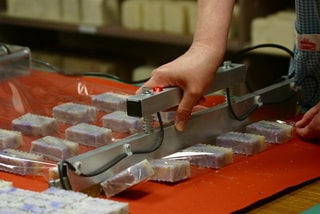For most soap makers, there are a plethora of ways to display, wrap and protect their soap for the trip to the consumer. If like us, a company sells to both the retail and wholesale market, that opens up a host of other issues to consider.
Acceptable plastic packaging alternatives
While we support efforts to reduce plastic packaging worldwide, especially that which ends up in landfills for several hundred years. If you spend a little time researching the issue, you will find there are acceptable plastic alternatives and plastic companies are heavily into researching how to turn the high-quality plastics into forms that are environmentally acceptable.
While we use kraft bio-degradable paper sacks for our online orders, we found it necessary to choose a more protective packaging at the request of Whole Foods and other stores that carry our product. Soap can sit on shelves for a significant amount of time. Dust can build up in less than 1 week. Store customers will pick up the product, potentially drop it and handle it several times before deciding on the purchase. Without a protective covering, soap will accumulate fingerprints and the bacterial footprint from each person that handles the bar. The packaging has to protect the product against both the environment and handling. Shrink-wrap was a technological advancement in the soap realm and has only continued to improve with time and research. This is an important issue to consumers and not just those who are “green or nature” oriented. Unfortunately, most consumers equate shrink-wrap with offensive plastic, which isn’t the case.
Biodegradable shrink-wrap
A company named Wells Plastics has created a biodegradable shrink-wrap film that has multiple applications besides soap. It can be used for food, baked goods & confections. This IS the film that we use for our soap. It is a hybrid. We use a custom formulated oxo-biodegradable film which has the benefits of being puncture-resistant, creates durable and strong seals, easy to cut and has excellent shrinkage with the heat gun. This same film is entirely micro-perforated to enhance the shrinking process and facilitate the escape of air.
Pluses and Minuses of Plastic Packaging Alternatives
The BEST part of this packaging is that is has been designed specifically to address the issue of plastic waste that gets into the environment and cannot be easily collected. But with the positives, come the challenges. First, we need to keep the film in a cool, dark place. Temperature and moisture will degrade the film. However, this is also a positive. Secondly, this Biolefin specialty film we are using is DOUBLE the price of traditional soap shrink-wrap. We’ve worked on negotiating the price of our paper sacks down as a means of bringing Biolefin to you.
Ideally, when the wrap reaches a landfill, which is usually a few months later, the breakdown of the film will kick into high gear. Exposure to moisture, light, wind, and temperature (which are landfill conditions), help break up the protective polymer chain and make it available for environmental forces to attack and break apart.
What’s next in plastic?
The next step in the industry is the continued development of multi-layer laminates used in bottling. We already use strong recyclable plastics and will switch to bottles & jars with total bio-degradability.
So just is just an update on our efforts to bring the best products to all consumers. It isn’t just what is INSIDE that makes a quality product. It is how it is packaged. The technology has arrived but has not yet been integrated fully into bottle and jar manufacturing. Our goal is to move to all bio-degradable packaging as soon as it is commercially available.


